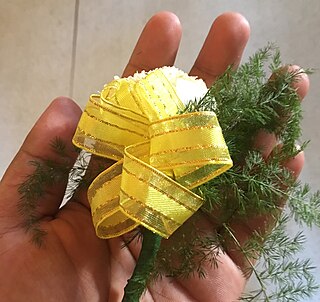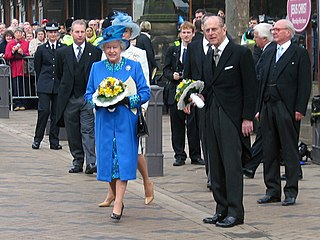 W
WFloristry is the production, commerce, and trade in flowers. It encompasses flower care and handling, floral design, or flower arranging, merchandising, production, display and flower delivery. Wholesale florists sell bulk flowers and related supplies to professionals in the trade. Retail florists offer fresh flowers and related products and services to consumers. The first flower shop opened in 1875.
 W
WThe Advent wreath, or Advent crown, is a Christian tradition that symbolizes the passage of the four weeks of Advent in the liturgical calendar of the Western church. It is traditionally a Lutheran practice, although it has spread to many other Christian denominations.
 W
WA Bough pot is a vessel for holding stems of flowers and branches to decorate an interior, especially a fireplace during summer. They are typically ceramic, and have a body to hold water, with a number of small openings for the stems in the top. Often the top lifts off. The tulipiere and flower brick are types that allow larger numbers of flowers.
 W
WA boutonnière or Buttonhole is a floral decoration, typically a single flower or bud, worn on the lapel of a tuxedo or suit jacket.
 W
WA chaplet is a headdress in the form of a wreath made of leaves, flowers or twigs woven into a ring. It is typically worn in festive occasions and on holy days. In ancient times it also served as a crown representing victory or authority.
 W
WA corsage is a small bouquet of flowers worn on a woman's dress or around her wrist for a formal occasion in the United States. They are typically given to her by her date. Today, corsages are most commonly seen at homecomings, proms, and similar formal events.The corsage is worn on a young woman's clothing or wrist for a homecoming celebration or other formal occasions such as prom in some schools around the world. In some countries, similar ornaments are worn by the mothers and grandmothers of the bride and groom at a wedding ceremony. In some cases, young girls may wear a corsage to a father-daughter dance, and the father may also wear a boutonnière.
 W
WCut flowers are flowers or flower buds that have been cut from the plant bearing it. It is usually removed from the plant for decorative use. Typical uses are in vase displays, wreaths and garlands. Many gardeners harvest their own cut flowers from domestic gardens, but there is a significant floral industry for cut flowers in most countries. The plants cropped vary by climate, culture and the level of wealth locally. Often the plants are raised specifically for the purpose, in field or glasshouse growing conditions. Cut flowers can also be harvested from the wild.
 W
WA Dutch flower bucket is the most common container used in the European floral industry to transport flowers, and to keep them watered along the way.
 W
WA floral clock, or flower clock, is a large decorative clock with the clock face formed by carpet bedding, usually found in a park or other public recreation area. Most have the mechanism set in the ground under the flowerbed, which is then planted to visually appear as a clock face with moving arms which may also hold bedding plants.
 W
WFloral design or flower arrangement is the art of using plant materials and flowers to create an eye-catching and balanced composition or display. Evidence of refined floristry is found as far back as the culture of ancient Egypt. Professionally designed floral designs, arrangements or artwork incorporate the elements of floral design: line, form, space, texture, and color, and the principles of floral design: balance, proportion, rhythm, contrast, harmony, and unity.
 W
WFloriculture, or flower farming, is a discipline of horticulture concerned with the cultivation of flowering and ornamental plants for gardens and for floristry, comprising the floral industry. The development, via plant breeding, of new varieties is a major occupation of floriculturists.
 W
WA flower bouquet is a collection of flowers in a creative arrangement. Flower bouquets can be arranged for the decor of homes or public buildings, or may be handheld. Handheld bouquets are classified by several different popular shapes and styles, including nosegay, crescent, and cascading bouquets. Flower bouquets are often given for special occasions such as birthdays, anniversaries or funerals. They are also used extensively in weddings. Bouquets arranged in vases or planters for home decor can be arranged in either traditional or modern styles. Symbolism may be attached to the types of flowers used, according to the culture.
 W
WFlower carpet is a carpet made of flowers arranged in patterns. Flower carpet events happen in many places around the world. One of the most popular flower carpet events is the Flower Carpet biennial in Brussels. Flower carpets are made on the occasion of Onam festival in Kerala, India to welcome the legendary king, Mahabali. The Guinness World Record for the largest flower carpet of the world is for Jardines of Mexico, where an 18,000 m2 flower carpet was made on 8 December 2018.
 W
WFlower preservation has existed since early history, although deliberate flower preservation is a more recent phenomenon. In the Middle East, the bones of pre-historic man were discovered with delicate wild flowers probably as a tribute to a passing loved one. Evidence of deliberate use of specific flowers is indicated by the pollen grains that were present. Brightly colored and vivid flowers were also found in Egyptian tombs. These flowers were approximated to be 4,000 years old. In the sixteenth century medicinal nosegays began to give way to ornamental ones. Flowers essentially started to be used for decorative purposes such as jewels, fans and gloves. During the Elizabethan Age the once familiar ruff was replaced by soft lacy collars, and bosom flowers also became popular.
 W
WA flower seller, normally a woman, traditionally sells flowers on the street. Often the flowers are carried in a basket, for example. The subject matter has been a favorite of artists. The profession has mostly died out in countries like the United Kingdom, but still exists in others such as India.
 W
WThe history of flower arrangement dates back to ancient Egyptian times.
 W
WA kenzan (剣山), also called spiky frog, is a specific device used in the Japanese art of flower arrangement ikebana for fixing the flowers in the container. It consists of a heavy lead plate with erected brass needles where the stipes are fixed.
 W
WKorean flower arrangement is being revived as an indoor art, and most often uses simple Joseon dynasty whiteware to highlight Korean flowers and tree branches in elegant and unforced natural arrangements. Im Wha-Kong of Ewha Woman's University in Seoul, who also makes her own ceramic wares, is the greatest living exponent of this art, and hosts quarterly displays of flower arrangements keeping this tradition alive. There are at least a dozen schools of traditional flower arrangements.
 W
WLan Caihe is a Chinese mythological figure, and one of the Eight Immortals in the Taoist pantheon. Presence in the Eight makes this figure one of the more familiar out of hundreds of other Taoist immortals. Lan Caihe is the only one of the Eight Immortals whose gender is ambiguous. Lan isn't generally thought to be based on a historical person, but is traditionally said to have been born sometime during the Tang dynasty, and lived as a homeless street entertainer, who wandered all over China, singing philosophical songs. Stories vary about how Lan attained immortality and became one of the Eight Immortals. Lan's emblem is a basket of flowers, and so this immortal is considered the patron of florists and gardeners.
 W
WA nosegay, posy, or tussie-mussie is a small flower bouquet, typically given as a gift. They have existed in some form since at least medieval times, when they were carried or worn around the head or bodice. Doilies are traditionally used to bind the stems in these arrangements. Alternatively, "posy holders", available in a variety of shapes and materials, enable the wearing of these arrangements "at the waist, in the hair, or secured with a brooch".
 W
WPressed flower art consists of drying flower petals and leaves in a flower press to flatten and exclude light and moisture. It has long been practised as an art form in China and in Japan, where it is known as oshibana (押し花). Outside of Asia, the art gained popularity in Britain during the Victorian era and experienced a revival from the 1970s to the early 2000s. Some artists outside of Asia have continued to use it.
 W
WA tulip vase, or pyramid vase, is a vase designed to put cut flowers and especially tulips in, but it primarily serves as a decorative showpiece. They were first made in the Netherlands in the 17th century and were decorated with Delfts blauw or Chinese decoration. Replicas of the original tulip vases were made in China and were imported by the Dutch East India Company.
 W
WThe White House Chief Floral Designer is responsible for the planning, design, arrangement and placement of all floral decorations for the First Family, their private entertaining, and official state functions at the White House, the official residence and principal workplace of the President of the United States. The current Chief Floral Designer is Hedieh Ghaffarian.
 W
WA wreath is an assortment of flowers, leaves, fruits, twigs, or various materials that is constructed to form a ring.